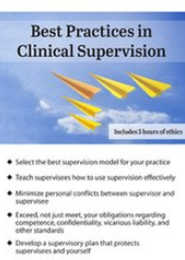This recording presents a blueprint, based on established best practices, for providing effective and ethical clinical supervision.
George Haarman – Best Practices in Clinical Supervision
ESTABLISH ROLES AND RESPONSIBILITIES
Administrative vs. clinical supervision
Role of the clinical supervisor
Teaching supervisees how to use supervision effectively
Assisting supervisees in taking an active role
CHOOSE THE MOST EFFECTIVE SUPERVISION MODEL FOR YOUR SETTING
Developmental models
Psychotherapy based models
Integrative models
Parallel process model
The supervisee as “patient”
MASTER EFFECTIVE METHODS AND TECHNIQUES OF SUPERVISION
Multicultural supervision
Individual vs. group supervision
Co-therapy vs. co-responsibility
Case consultation
Written activities and case notes
Live observation
Interactive live supervision
Audio and video recording of sessions
Experiential methods
AVOID AND RESOLVE PROBLEMS THAT ARISE DURING SUPERVISION
Ethical
Supervisor competence
Informed consent
Boundary issues
Dual relationships
Supervisor/supervisee obligations
Incompetent or impaired supervisees
Sexual attraction
Confidentiality
Documentation
Evaluation and feedback
Legal
Vicarious liability
Standard-of-care
Negligence
Confidentiality vs. privilege
Duty to warn/report
Due process
Risk management
Knowledge of ethical codes and mental health law
Supervision contracts
Boundaries of competence
Consultation supervision
Documentation
Ongoing training in supervision
Liability insurance coverage
Insuring confidentiality
Supervisory malpractice
PROPERLY EVALUATE SUPERVISEES AND SUPERVISION
Formative vs. summative evaluations
Criteria for evaluation
Standardization of methods
Self-evaluation
Objective evaluation tools
Supervisory evaluation
360-degree feedback
Develop a supervisory plan
CASE STUDIES
Would you like to receive George Haarman – Best Practices in Clinical Supervision ?
Description:
Are you considering joining the ranks of those who are approved to provide this invaluable oversight of fellow professionals? Are you already a clinical supervisor and need to formalize and enhance your knowledge and skills? This recording presents a blueprint, based on established best practices, for providing effective and ethical clinical supervision.
Explore clinical supervision through the lens of critical legal, ethical, and risk management issues. Gain clarity on how to define the goals of supervision, as well as the responsibilities of both supervisor and supervisee. Analyze the “How Do I?” of clinical supervision, with details on individual vs. group supervision, case consultation, interactive live supervision, audio and video sessions, and other methods and techniques. Determine how to meet, and then exceed, your obligations regarding competence, confidentiality, vicarious liability, and other standards.








